The best countertop reverse osmosis systems are extremely high-performing and can reduce hundreds of impurities from water. They’re also highly efficient and waste less water than conventional RO systems, and are easy to install due to their plug-and-play designs.
We conduct our own hands-on testing to obtain the data we need to review and compare water filters. All the RO systems in this guide were personally tested by Brian, the founder of Water Filter Guru, WQA Certified Water Specialist (CWS), and Certified Water Treatment Representative (CWR), who has been testing and reviewing water filters for 10+ years.
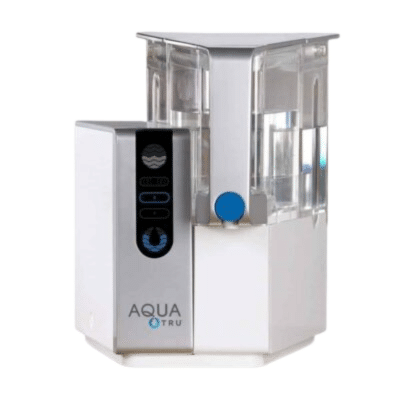
AquaTru
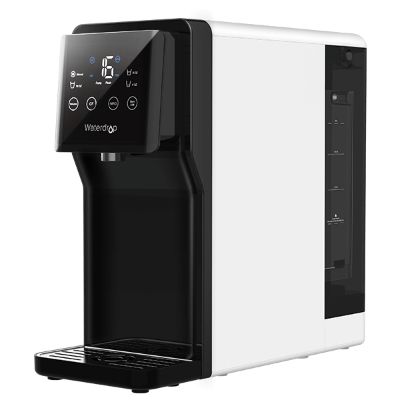
Waterdrop N1
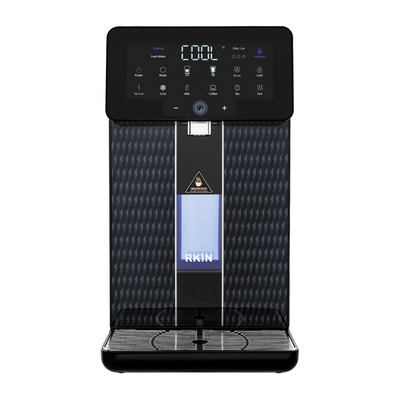
RKIN U1
Table of Contents
Our Testing & Selection Process
The 5 Best Countertop Reverse Osmosis Systems
| Product |  AquaTru | 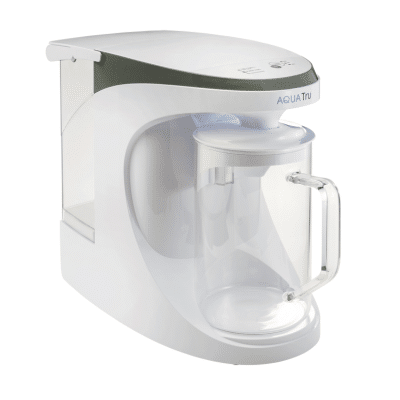 AquaTru Carafe |  Waterdrop N1 |  RKIN U1 | 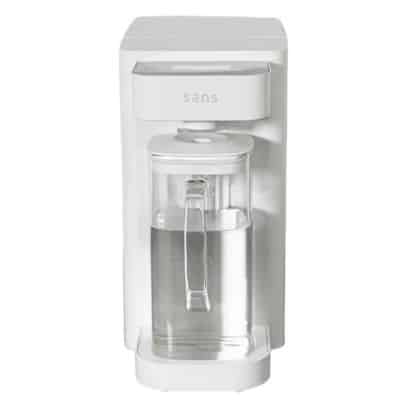 Sans | 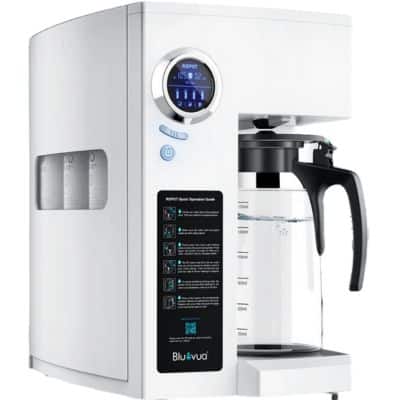 Bluevua ROPOT | 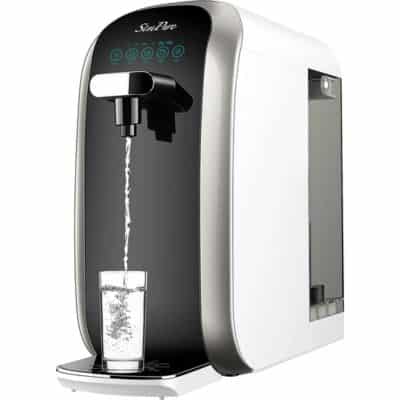 Simpure Y7P |
|---|---|---|---|---|---|---|---|
| Score | 9.54 | 9.57 | 9.03 | 8.83 | 8.71 | 8.68 | 8.04 |
| Price | $449.00 | $359.00 | $299.00 | $749.95 | $499.99 | $454.00 | $369.99 |
| Certifications | NSF/ANSI 42, 53, 58, 401, and P473 | NSF/ANSI 42, 53, 58, 401, and P473 | Not Certified | Not Certified | Not Certified | Not Certified | NSF/ANSI 58 (Materials Requirements Only) |
| Filter Capacity | 600 – 1,200 gallons | 300 – 1,200 gallons | 550 – 1,600 gallons | 6, 12, 24 months | 600 – 1,200 gallons | 538 / 1,076 / 260 gallons | 528 gallons |
| Cost per Gallon | $0.11 | $0.19 | $0.09 | $0.08 | $0.14 | $0.27 | $0.10 |
| Warranty | 1 year | 1 year | 1 year | 1 year | 3 years | 1 year | 1 year |
| Read Review | AquaTru review | AquaTru review | Waterdrop N1 review | RKIN U1 review | Bluevua ROPOT review | Simpure Y7P review |
AquaTru

The AquaTru is our top recommended countertop reverse osmosis system because it reduced more contaminants than any other RO system in our testing. It also got the best score overall because it did better than any other system across almost every performance category.
We recommend both AquaTru models: the full-size AquaTru Classic, and the smaller, more compact AquaTru Carafe.
Best For
Product Specs
| Price | $449.00+ |
| Contaminants Reduced | 83+ |
| Certifications | NSF 42, 53, 58, 401, and P473 |
| Process | Mechanical + RO + Carbon |
| Production Rate | 600 – 1,200 gallons |
| Annual Cost | ~$100 |
| Warranty | Lifetime |
Why It’s Best
The AquaTru is the best overall countertop RO system because both the full-size Classic model and the AquaTru Carafe did better than any other system we tested at reducing contaminants in our water.
Our post-filtration results showed that the AquaTru had reduced 100% of all the trace contaminants in our water, making it the only reverse osmosis unit we tested that purified our water completely.
It’s also the only countertop RO system to have obtained performance certifications for every single contaminant it’s claimed to reduce – and it has a better pure-to-wastewater ratio than any other system.
AquaTru Performance
AquaTru scored the highest overall performance score out of any RO system we tested:
- The AquaTru Classic system received a score of 9.54 out of 10
- The AquaTru Carafe got a slightly higher score of 9.57 due to its glass collection vessel (the Classic system collects water in a plastic vessel).
These are two of the best scores our scoring system has ever awarded, and are currently higher than any other countertop RO system has obtained.
Both systems use the same filter technology (the only difference is that the AquaTru Carafe’s filters are smaller), so both performed very similarly in our testing.
For reducing health-related contaminants in our water, the unit received a score of 9.90. It eliminated 100% of all contaminants with possible health effects, including lead, strontium, uranium, fluoride, molybdenum, and barium. It also got a 9.90 score for aesthetic contaminants because it reduced 100% chlorine in our water.
A standout performance feature of the AquaTru is that it’s IAPMO certified to NSF Standards 42, 53, 58, 401, and P473 for the reduction of all 83 contaminants that AquaTru claims it can reduce. Many of its competitors aren’t certified at all, and others are only certified to reduce a handful of contaminants.
AquaTru also got the best design scores of any countertop RO unit we tested:
The Carafe version received a 10.00 (equal only to the Bluevua ROPOT, which also uses a glass collection carafe), and the Classic model earned a respectable 9.70.
We had no complaints about its component quality, and its IAMPO performance certification also incorporates a materials safety certification. Even better, it has an NSF 372 certification for lead-free design.
AquaTru also did better than its competitors with its 4:1 recovery rate, meaning that only 1 gallon of water was wasted for every 4 gallons purified.
We awarded both AquaTru models we tested 10.00 and 9.75 scores for setup and maintenance.
We didn’t have to prime the filters, and the units arrived partially assembled. They both feature a display screen that notified us whenever a filter needed replacing, and the Classic unit’s ongoing cost of $0.11/ gallon was super affordable.
Even the Carafe model, which has smaller filters with shorter lifespans, has an affordable maintenance cost of $0.19/ gallon—although it’s not the absolute cheapest we’ve tested in terms of ongoing costs.
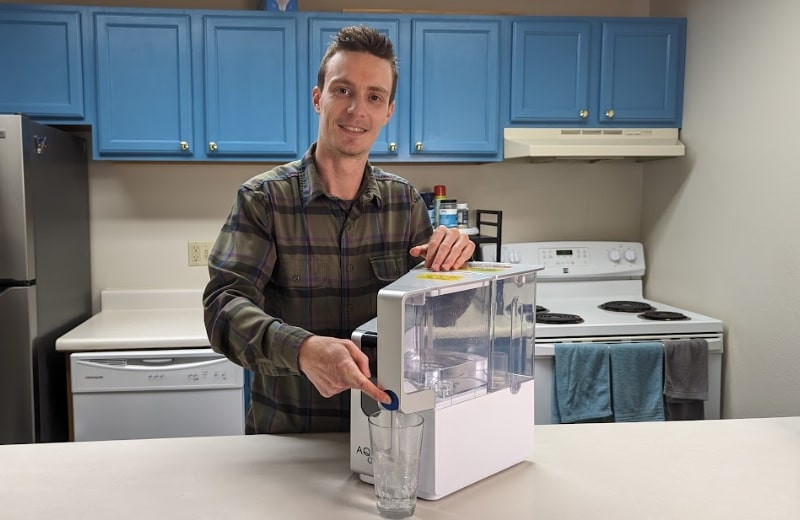
We think the AquaTru is the best countertop reverse osmosis system for folks who want a top-performing certified unit with the option for a remineralization upgrade.
| Criteria | Results |
|---|---|
| Overall Score | 9.54 |
| Health Related Contaminants | 9.90 |
| Aesthetic Related Contaminants | 9.90 |
| Performance Certification | Certified for 100% of reduction claims |
| Filtration Rate | 0.04 GPM |
| Component Quality | Outstanding |
| Component Certification | Exceptional |
| Setup | Exceptional |
| Servicing Requirements | Outstanding |
| Costs | $0.11/ gallon |
| Warranty Length | 1 year |
| Shipping | Free shipping |
| Returns | 30 days |
Waterdrop N1

The Waterdrop N1 is a more affordable alternative to the AquaTru that performed very similarly in our testing. It reduced or removed 10+ contaminants in our water, including copper, lead, barium, nitrate, uranium, zinc, and strontium.
Best For
Product Specs
| Price | $299.00 |
| Contaminants Reduced | 10+ |
| Certifications | – (Not specified) |
| Process | PP Cotton + Carbon Block + RO Membrane |
| Filter Capacity | 550 – 1,600 gallons |
| Annual Cost | ~$70 |
| Warranty | 1 year |
Our Verdict
The Waterdrop N1 is our second-choice countertop reverse osmosis water filtration system, which you might prefer if your budget is a little smaller.
It wasn’t quite as high-performing as the AquaTru, but it still got great scores for contaminant reduction, design, setup, and maintenance.
The system eliminated 100% of most contaminants in our water, and we awarded it top scores for reducing health-harmful and aesthetic contaminants. Our only disappointment was that it doesn’t have a remineralization filter.
The N1’s efficiency ratio is 3:1, putting it just behind AquaTru (which has a 4:1 efficiency ratio).
Waterdrop N1 Performance
The Waterdrop N1 received a 9.25 score for contaminant reduction. In our testing, it reduced 100% barium, chlorine, copper, lead, molybdenum, nitrate, phosphorous, strontium, sulfate, uranium, and zinc.
It reduced just over 93% fluoride, which was good, but not as impressive as the RO systems that eliminated this contaminant.
The N1 isn’t performance-certified, which was the main reason why its overall contaminant reduction score was lower than AquaTru’s.
We awarded the unit a score of 8.10 for design. Again, it didn’t quite match up to AquaTru here because it doesn’t have a materials safety certification, which pulled its score down. But in terms of design, feel and quality, it was no different from the AquaTru. It has a majority plastic design, and the components that the water comes into contact with are made from BPA-free Polypropylene (PP).

Setup and maintenance were two performance categories in which the Waterdrop N1 excelled, receiving 9.50 and 10.00 scores for each. Like the AquaTru, the N1 is a plug-and-play machine that comes with the filters pre-installed. We just rinsed and flushed the system a few times following instructions in the manual.
Replacing the filters was easy and didn’t require any special knowledge. The N1 also has a screen that displays filter change reminders, and its ongoing cost is slightly lower than AquaTru’s at just $0.09/ gallon. A unique feature of this system that made maintenance easier was its internal UV light. This sterilizes the purified water holding tank, so it doesn’t have to be taken apart to be cleaned.
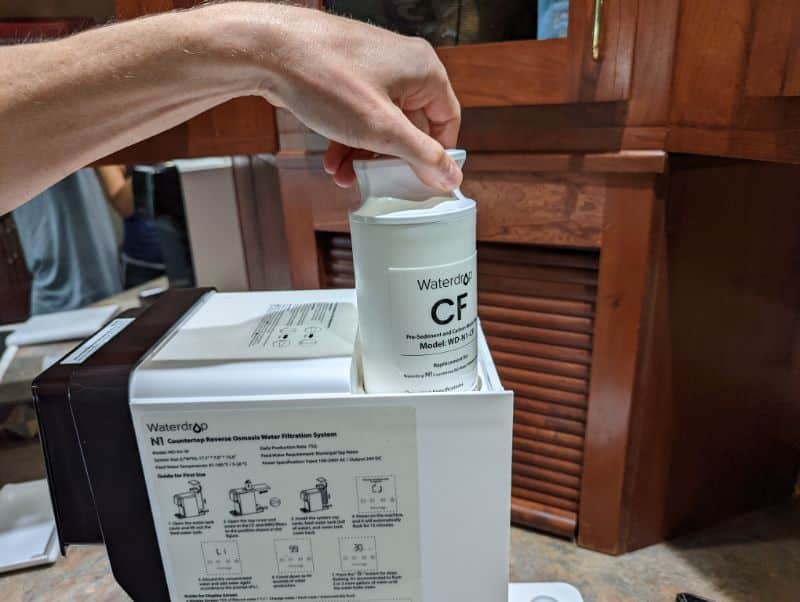
We recommend the Waterdrop N1 to anyone who wants a more affordable alternative to the AquaTru, with very similar contaminant reduction and efficiency data but no option to upgrade to a remineralization filter.
| Criteria | Results |
|---|---|
| Overall Score | 9.03 |
| Health Related Contaminants | 9.60 |
| Aesthetic Related Contaminants | 9.90 |
| Performance Certification | Not certified for any reduction claims |
| Filtration Rate | 0.1 GPM |
| Component Quality | Fair |
| Component Certification | Not certified |
| Setup | Outstanding |
| Servicing Requirements | Exceptional |
| Costs | $0.09/ gallon |
| Warranty Length | 1 year |
| Shipping | Free shipping to lower 48 |
| Returns | 30 days |
RKIN U1

The RKIN U1 is the most advanced, tech-forward RO system we’ve tested. It eliminated the majority of contaminants in our water and then delivered it at any temperature, hot or cold, at the press of a button. It’s also the only system on this list with a built-in remineralization filter.
Best For
Product Specs
| Price | $749.95 |
| Contaminants Reduced | 10+ |
| Certifications | NSF 58 (in progress) |
| Process | Mechanical + Carbon + RO + Alkaline + Hydrogen infusion |
| Filter Capacity | 6, 12, 24 months |
| Annual Cost | ~$180 |
| Warranty | 1-year warranty & 1 year money-back guarantee |
Our Take
The RKIN U1 has the highest price point of any of the countertop filtration systems we’ve tried, but it also offers far more in terms of features and benefits. It’s the only system we tested that delivers hot and cold water at any temperature of your choice, and it remineralizes water with a built-in filter.
The unit performed very similarly to AquaTru when reducing contaminants. But it got a slightly lower health-related contaminant score due to the addition of some substances.
RKIN U1 Performance
The RKIN U1 secured a 9.00 score for contaminant reduction. It eliminated 100% chlorine, copper, fluoride, lead, molybdenum, uranium, and zinc, and greatly reduced barium, nitrate, and sulfate.
But its overall score was impacted by the fact that strontium increased from 0.108 PPM to 2.42 PPM in our filtered water, most likely from the remineralization filter. The unit also lacks a performance certification.
The system got good scores in the setup and maintenance categories: 10.00 and 9.75 respectively. The U1 is also a plug-and-play system, and it has a flush function that you can activate by pressing a button, so we didn’t have to manually prime or flush the filters. Our estimated ongoing cost for the system was $0.0809/ gallon, making it the most affordable to maintain in the long run, despite having the highest upfront cost.
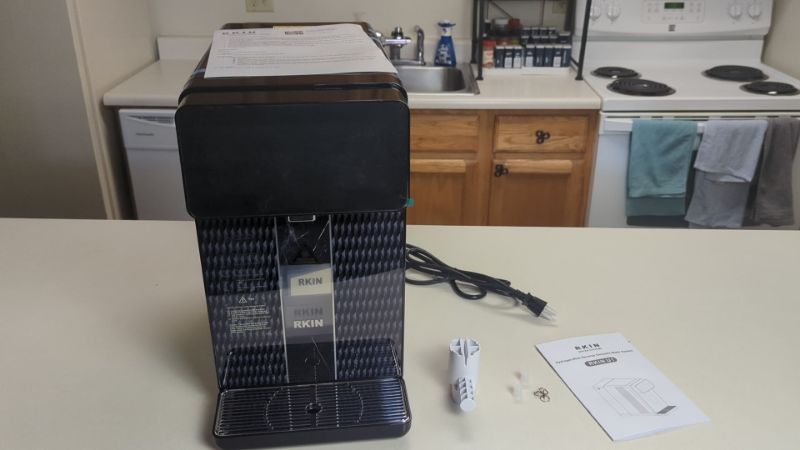
The U1’s filtration rate let it down slightly – it was just 0.07 GPM (AquaTru’s measured at 0.08 GPM, while the Waterdrop N1’s was better at 0.1 GPM). It also has a 1:1 efficiency ratio, so it’s not quite as efficient as the AquaTru or N1.
In the design category, we were pleased with the U1’s component quality, but it was lacking a materials safety certification.
In our opinion, the U1 is the best choice for folks who want the leading high-tech RO system with a host of perks and add-ons that are rarely found all in one unit. If you use a lot of hot water and want to purify it easily, the U1 makes sense for you.
| Criteria | Results |
|---|---|
| Overall Score | 8.86 |
| Health Related Contaminants | 9.30 |
| Aesthetic Related Contaminants | 9.90 |
| Performance Certification | Not certified for any reduction claims |
| Filtration Rate | 0.07 GPM |
| Component Quality | Outstanding |
| Component Certification | Not certified |
| Setup | Exceptional |
| Servicing Requirements | Exceptional |
| Costs | $0.08/gallon |
| Warranty Length | 1 year |
| Shipping | Free shipping on orders over $175 to lower 48 states |
| Returns | 30 days |
Related Review: Top Ranked Apartment Water Filters
Sans Water Purifier

The Sans RO Water Purifier has a few unique benefits: a glass carafe, hot water dispensing, and optional remineralization. It performed pretty well across all testing categories and has a great 3:1 pure-to-wastewater ratio, but it wasn’t the best system overall, with a few setbacks—you can’t select your exact hot water temperature, the purified water is stored in a plastic tank before dispensing into the carafe, and the unit has no certifications for its design safety or contaminant removal performance.
Best For
Product Specs
| Price | $499.99 |
| Contaminants Reduced | 10+ |
| Certifications | – Not Certified |
| Process | Carbon + RO + UV + Remin |
| Filter Capacity | 600 / 1,200 gallons |
| Annual Cost | ~$125 |
| Warranty | 3 years |
What it Removed
Starting with contaminant removal, Sans received an 8.66 score in this category. It eliminated all uranium and fluoride (both detected above the HGL in our water), as well as 100% nitrate, phosphorus, molybdenum, copper, chlorine, and zinc. It also greatly reduced sulfate by 80%, barium by 96%, and strontium by 85%.
There were no anomalies with our test results, although carbonate in our water did increase by 7,262%. This was likely because we got the system with the remineralization filter integrated into the final carbon VOC filter, with our results suggesting that the filter is made from calcite (a form of calcium carbonate), which dissolves into the water.
Speaking of remineralization, we still saw an overall decrease in calcium and magnesium, but the pH of our water increased from 7.2 to 9.7 (alkaline), demonstrating that the filter was working correctly.
Disappointingly, Sans hasn’t yet obtained any performance certifications; there’s a test report on the website, but that’s from the company’s own third-party lab testing.
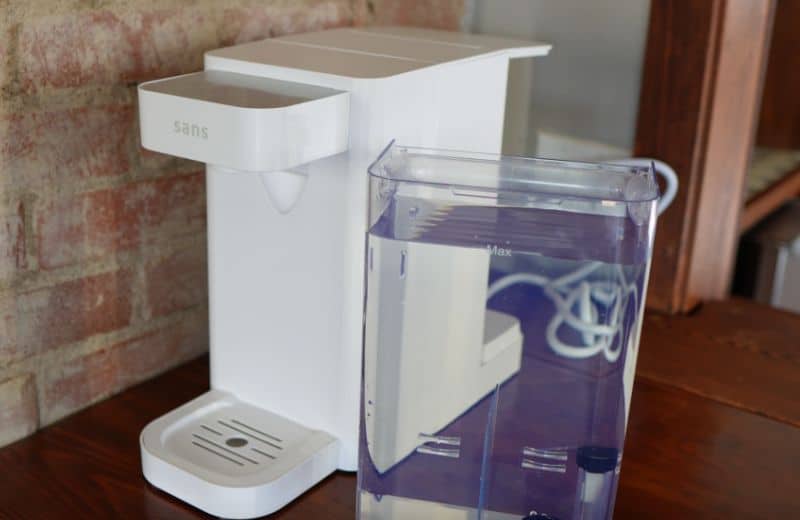
The system’s 0.046 GPM filtration rate makes it one of the slower models we’ve tested, earning it a score of score 7.00 in this category. It filters water into a glass carafe, but first, the purified water gets stored in a plastic internal tank first—a weird design choice in our opinion.
Despite this, we still awarded the unit a 9.50 component quality score, as it feels sturdy and well-made, but its lack of a materials safety certification pulled the overall design score down to 8.10.
Like the other systems we reviewed, the Sans RO was easy to assemble and maintain, receiving setup and maintenance scores of 10.00 and 9.50. The unit arrived with the filters installed and ready to use after flushing (an easy but time-consuming process that took 36 minutes overall), and its cost-per-gallon of $0.14 makes it super affordable to use long-term.
The Bottom Line
The Sans RO Water Purifier is a bit pricier than similar systems and doesn’t offer that many features to justify its cost. We think it’s great if you want an RO unit that delivers hot water and has a built-in UV cleaning feature, but without all the extra features (and bulk) of the RKIN U1. But, the internal plastic storage tank negates the purpose of the glass carafe for purified water collection.
The unit performed well overall, and while it didn’t get the highest scores overall, it still greatly reduced or removed all detectable contaminants in our water, with no unexpected or concerning outcomes.
| Criteria | Results |
|---|---|
| Overall Score | 8.71 |
| Health Related Contaminants | 8.90 |
| Aesthetic Related Contaminants | 9.90 |
| Performance Certification | Not Certified |
| Filtration Rate | 0.046 GPM |
| Component Quality | Outstanding |
| Component Certification | Unsatisfactory |
| Setup | Exceptional |
| Servicing Requirements | Outstanding |
| Costs | $0.14/ gallon |
| Warranty Length | 3 years |
| Shipping | Free Shipping |
| Returns | 30 days |
Bluevua ROPOT(UV)

The Bluevua ROPOT(UV) is the third countertop RO system we’ve reviewed that collects water in a glass container. It has built-in UV protection and comes with a remineralization filter that adds healthy minerals back into the purified water—but it’s not performance certified and it struggled to completely remove all contaminants from our water.
Best For
Product Specs
| Price | $454.00 |
| Contaminants Reduced | 1000+ |
| Certifications | – Not Certified |
| Process | Mechanical + Carbon + RO + UV + Remin |
| Filter Capacity | 538 / 1,056 / 260 gallons |
| Annual Cost | ~$169.86 |
| Warranty | 1 year |
How it Performed
In our performance testing, Bluevua eliminated all uranium—which was detected in concentrations exceeding the Tap Score HGL—but it only reduced fluoride (also exceeding the HGL) by 83%.
The system also completely removed nitrate, chlorine, sulfate, copper, and molybdenum by 100%, and reduced barium by 77% and strontium by 75%.
It performed well, but we’ve seen more thorough contaminant reduction from other countertop RO systems. Plus, it’s not performance certified, despite Bluevua misleadingly claiming to have an “Official Third Party Certification” and using its WQA Gold Seal certificate (for lead-free design only) in a way that suggests this is for contaminant reduction. This landed it a slightly lower score of 8.23 for contaminant reduction.
On a more positive note, the remineralization filter appeared to do its job well, as we only saw an 86% reduction of calcium and a 60% reduction of magnesium (rather than 100%).
Plus, the pH of our water increased from 7.1 to 9.0, likely due to the addition of alkaline-enhancing minerals.
The system’s 0.06 GPM filtration rate is pretty standard for a countertop RO system using an electric pump, earning it a score of 7.50, and its 2:1 efficiency ratio is good, although not the best we’ve seen.
The UV purification light is a nice touch and protects the unit from bacteria buildup in the filters, but it should still only be used with treated, potable water.
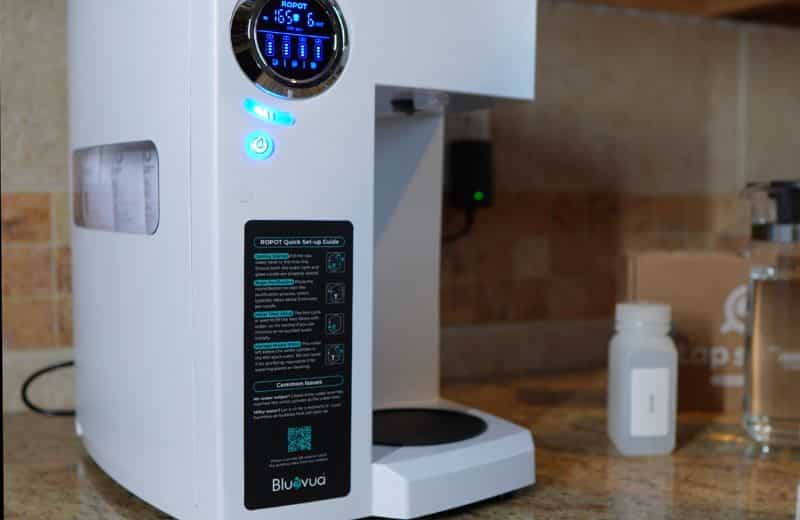
Our Thoughts
There were a few features of the Bluevua ROPOT system that we enjoyed.
The system feels sturdy, with a polyamide and polypropylene plastic design, and we were pleased to see at least one certification: NSF/ANSI 372, awarded by the WQA for lead-free design.
We appreciated the convenience of the water collecting directly in the glass carafe, so we didn’t have to stand around manually dispensing it ourselves.
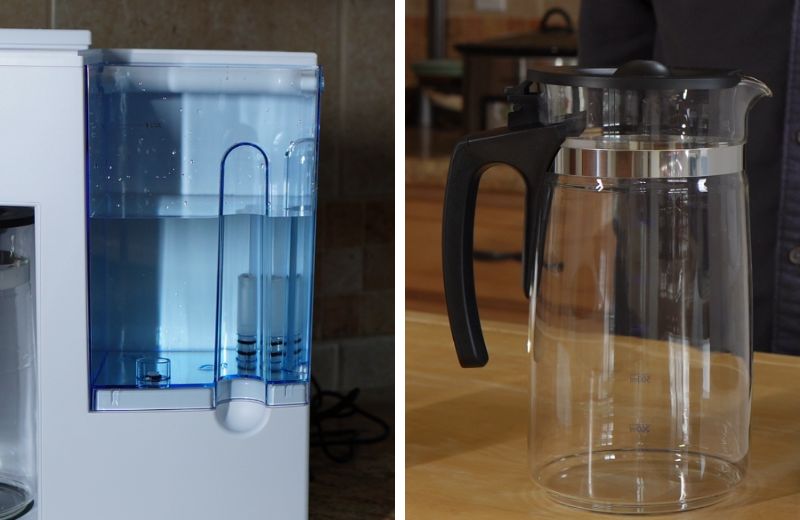
And speaking of the glass carafe, Bluevua is one of the only manufacturers (alongside AquaTru) to use a glass collection vessel, which you’ll probably prefer if you don’t want to expose your purified water to microplastics. This earned it a design score of 10.00.
Setup was quick and easy, and the system received another 10.00 in this category, with no unexpected tasks for a plug-and-play countertop RO system. We also found it easy to stick to the maintenance schedule, with the display screen notifying when filter changes were required.
Bluevua’s total maintenance spend came to $0.27/ gallon, making it one of the more “expensive” on-counter reverse osmosis systems we’ve still tested, but still very affordable even compared to non-RO filters. Its overall maintenance score came in at 9.75.
We think the Bluevua ROPOT(UV) is ideal for folks who specifically want a system with built-in UV purification that collects water in a glass carafe.
| Criteria | Results |
|---|---|
| Overall Score | 8.68 |
| Health Related Contaminants | 8.40 |
| Aesthetic Related Contaminants | 9.90 |
| Performance Certification | Not Certified |
| Filtration Rate | 0.06 GPM |
| Component Quality | Exceptional |
| Component Certification | NSF 372 |
| Setup | Exceptional |
| Servicing Requirements | Outstanding |
| Costs | $0.27/ gallon |
| Warranty Length | 1 year |
| Shipping | Free Shipping to continental US |
| Returns | 30 days |
Simpure Y7P

The Simpure Y7P rivals AquaTru with its 4:1 efficiency ratio. It uses a water recycling system that minimizes wastewater production as much as possible, and in our testing, it completely eliminated most contaminants. But, this is another unit that hasn’t been performance certified (despite misleading claims on the product page). It also has no optional remineralization upgrade, some of its design elements felt flimsy, and the pure water tank is small and fills quickly.
Best For
Product Specs
| Price | $369.99 |
| Contaminants Reduced | 1000+ |
| Certifications | NSF 58 (Materials Requirements Only) |
| Process | Mechanical + Carbon + RO |
| Filter Capacity | 528 gallons |
| Annual Cost | ~$114 |
| Warranty | 1 year |
Testing Notes
In our testing, the Simpure Y7P actually got the lowest overall performance score of all countertop RO systems we’ve tested so far: 8.04.
This was largely due to a number of design elements that let it down (we’ll discuss later), as well as a few issues with its contaminant reduction performance.
Starting with the positives, the Y7P did a great job of completely eliminating fluoride and uranium (both detected above the HGL), as well as barium, copper, chlorine, strontium, and sulfate. It also greatly reduced nitrate by 78%.
But there were a couple of reasons why the system’s contaminant reduction score was brought down to 8.23:
- First, there’s no remineralization filter (and no optional upgrade either—you can only choose one of Simpure’s other products that do have this feature). As a result, our purified water was highly deficient in magnesium, calcium, and sodium, and had an acidic pH of 6.3 (reduced from 7.1).
- Second, the system hasn’t been performance certified, putting it behind many of the other systems that have. Misleadingly, SimPure claims that the system has been “SGS tested and certified”, making us believe that SGS is an industry accepted certification body (it isn’t).
The unit’s 0.5 GPM filtration rate earned it a score of 7.00, making it one of the slowest of a slow bunch, but its 4:1 pure-to-wastewater ratio is a huge redeeming factor. It continuously circulates water through the filters until the inlet tank is nearly empty, reducing wastewater production as much as possible.
Our Feedback
We were generally pleased with the look and feel of the Y7P system. Design-wise, it’s no different from other countertop RO systems, with an electric pump and built-in filter cartridges. It’s also certified for materials requirements only under Standard 58 by the NSF.
In terms of its appearance and functionality, we found the system similar to Waterdrop N1, which, at the time of writing this, is around $150 cheaper.
There were, however, a few design issues that we noted, bringing its score down to 8.50.
- First, having a small pure water tank was a hassle because we’d have to dispense all the water from it every time it got full if we wanted to purify all the water from the unfiltered water tank.
- Plus, the unit beeps annoyingly for around 20 seconds to let you know when there’s a shortage of pure water, as well as when you remove the unfiltered water tank to fill it up.
- We also noted that the cupholder that goes under the dispenser spout is made from cheap plastic.
- And finally, we found that the lid that covers the unfiltered water tank slips down and gets in your way when you’re trying to install the tank after filling it up.
Despite being a plug-and-play system like the other RO filters we reviewed, SimPure got a low score of 7.00 for setup. This was because the filter flushing process takes up to 2 hours due to the small holding volume of the internal pure water tank compared to the unfiltered water tank.
We had to wait for the pure water tank to be filled, then manually flush it. Then we had to wait for it to fill again, then manually flush it. This was repeated again and again until the unfiltered water tank was emptied and needed to be refilled.
The unit’s maintenance score was also brought down to 8.50 because we’ll have to repeat this annoying priming process every time we replace a filter—despite the Y7P’s overall maintenance cost being attractively low at just $0.10/ gallon.
We don’t think any of these issues are dealbreakers, and if you’re not bothered about remineralization or a few design issues, the SimPure Y7P’s impressive contaminant reduction performance might be exactly what you’re looking for.
| Criteria | Results |
|---|---|
| Overall Score | 8.04 |
| Health Related Contaminants | 8.40 |
| Aesthetic Related Contaminants | 9.90 |
| Performance Certification | Not Certified |
| Filtration Rate | 0.05 GPM |
| Component Quality | Below Average |
| Component Certification | Exceptional |
| Setup | Weak |
| Servicing Requirements | Weak |
| Costs | $0.10/ gallon |
| Warranty Length | 1 year |
| Shipping | Free shipping to continental US |
| Returns | Only available for certain conditions – No trial period/ guarantee |
Considerations When Buying a Countertop RO Filter
Water Source
Your water source is worth considering when looking for a count RO water filtration system.
In general, RO removes the great majority of contaminants from water, but some contaminants may cause membrane fouling. It’s important to consider if any pre-treatment is required, based on the operating parameters of the specific model you are considering.
Produced Water vs Waste Water
The nature of the reverse osmosis process is that as water is produced, water is wasted. When water is forced through the RO membrane, there has to be somewhere for the contaminants, which aren’t able to pass through the membrane, to go. Instead of building up in the chamber in front of the RO membrane, they’re continuously sent down a drain during the RO process. This naturally wastes water while the contaminants are removed.
Most conventional RO systems have a 4:1 ratio, which means that for every 4 gallons of wasted water, 1 gallon of purified water is produced. However, countertop reverse osmosis systems are much more efficient, producing up to 4 gallons and just wasting one.
Remineralization Needs
Some reverse osmosis water filters designed for countertop use have alkaline remineralization filters that reintroduce healthy minerals to your drinking water after filtration. If you prefer the taste of mineral water, or you like the health benefits that come from drinking it, you’ll want to look for a filter that offers an optional remineralization stage.
You can buy these filters separately for an under-sink filter, but it’s naturally more difficult with a reverse osmosis water filter system, which either does or doesn’t have the room for a remineralization stage.
Storage Capacity
This consideration is applicable if you’re looking to buy an RO filter that doesn’t connect to a faucet. This type of filter will have a storage tank for water, and once all that water has been used up, it’ll be your job to refill it. It goes without saying, then, that you’ll want the greatest possible storage capacity to reduce your work. Most RO filter systems have a storage capacity of at least 1 gallon, so set this as your benchmark.
Filter Lifespan
You should always be aware of the lifespan of an RO system’s water filters before you buy it. Filters that have a short lifespan will contribute to a higher system cost in the long run. Aim to find a pre-filter and post-filter with a 6-month lifespan, and a minimum of 2 years for the reverse osmosis filter membrane.
Counter Space Available
No matter what kind of reverse osmosis countertop system you’re looking at, you need to have the space available for it. If your countertop space is fairly limited, look at the systems with a smaller footprint that don’t take up so much room width-ways.
To avoid buying a system that’s too big and having to send it back, measure your available space and compare it to the dimensions of any of the reverse osmosis water filters you’re considering. Luckily, you don’t have to worry about under-sink space for installation, but you don’t want the system to clutter your only available side space, either.
Certifications
A certification can provide peace of mind that a portable countertop reverse osmosis system has been third-party tested and approved for its contaminant removal claims.
Two certifications you’ll see a lot of when searching for reverse osmosis filters are NSF 58 and 372, for material safety and lead-free components. You may also find systems that are certified for NSF 42, for chlorine removal, and 53, for lead removal.

